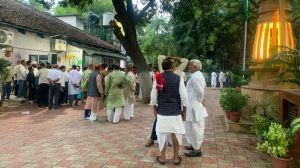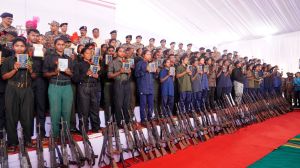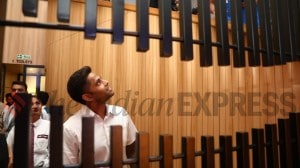Motivated, dedicated, and dreaded
They call themselves the Army of Allah and fight and die in the name of the Prophet. Eclipsed in recent times by the Lashkar-e-Toiba, the ...

They call themselves the Army of Allah and fight and die in the name of the Prophet. Eclipsed in recent times by the Lashkar-e-Toiba, the Pan-Islamic Harkat-ul-Mujahideen is back in the limelight thanks to the hijack drama. The hijackers demanded the release of Harkat leader Maulana Masood Azhar in exchange for the hostages.
Now the Harkat suicide attack and the 24-hour siege on the headquarters of the J&K Police’s elite counter-insurgency wing — the Special Operations Group (SOG) — at Srinagar is being seen as an attempt to consolidate its position. Ten policemen including an officer were killed while three Harkat militants who had stormed the complex died in the attack.
The Harkat first came into the limelight in Kashmir, when it banned the Amarnath Yatra in 1993 “in retaliation to the demolition of the Babri Masjid.” It demanded the reconstruction of the mosque and wanted other closed mosques to be reopened. The group again made news when it kidnapped two Britons from Aroo, Pahalgam on June 6, 1994and was also suspected to be involved in the abduction of five western tourists in July 1995, allegedly by “masquerading as Al-Faran”. The two Britons were released unhurt after the intervention of the Mirwaiz of South Kashmir, the late Qazi Nisar.
However, the Harkat denied any role in the latter abduction. Of these western tourists, one escaped, a Norwegian national was beheaded, while on Thursday, the police announced that DNA tests had confirmed that a body exhumed in south Kashmir in 1997 was of Paul Wells, also among the tourists abducted. The fate of the other two remains unknown. (See box for details of Harkat activities).
The Harkat-ul-Mujahideen emerged in 1985 as a splinter group of the pan-Islamic militant outfit Harkat-e-Jehadi-Islami (HEJI). It is learnt that a senior leader of HEJI, Maulana Fazlul Rehman Khalil, parted ways after problems cropped up between him and HEJI Amir (chief) Qazi Saifullah over the launch of the Harkat-ul-Mujahideen. Qazi was succeeded by Maulana Irshad Ahmad asHEJI Amir but died fighting in Afghanistan in 1991.
The parent HEJI was launched in 1980 with its headquarters in Pakistan and Afghanistan and its focus on the Afghan war. Aligned to the Deobandi school of thought, HEJI emerged as the armed wing of the Jamiat-e-Ulemai Pakistan, an organisation of Islamic clergy fighting the Soviet Union in Afghanistan. Security agencies in the Valley believe it was involved in the Kashmir insurgency as early as 1989. However, its role was then limited to training Kashmiri youth. Around 1,000 Kashmiri youths belonging to the Jammu and Kashmir Liberation Front (Farooq Haider group) were trained in camps run by the outfit in Afghanistan and PoK.
Sources said Maulana Shahadatullah took over as HEJI Amir after the killing of Maulana Irshad in 1991. It is said that Shahadatullah wanted to reunite the Harkat-ul-Mujahideen with HEJI so that “by combining the sources of finance, weapons and cadre, the outfit can operate effectively and make its presence felt.” Irshad sought thehelp of the clergy and following the efforts of Maulana Qaleemullah, Chancellor of Darul-Uloom Jamia Farooqi, Karachi, Mufti Rasheed Ahmad, Chancellor, Darul-Ifta-Wal-Irshad, Karachi and Maulana Rafi Usmani, the two factions finally agreed to merge as Harkat-ul-Ansar. The unification process took a few years and according to police sources in Srinagar, Maulana Masood Azhar, general secretary of the unified outfit, was specially sent to implement the merger on the ground in Kashmir. The police claim Azhar sneaked into India on a Portuguese passport, identifying himself as Issa Wali Adam.
Azhar had flown from London to New Delhi via Bangladesh and entered Kashmir on February 9, 1994. But he was arrested along with senior Harkat commander Sajjad Afghani at Khanabal on April 13, 1994 by the Army, though the date of his arrest was later shown as July 16, 1994. The duo were booked under TADA (FIR 1/9) in the Police Station (Counter-Intelligence), Kashmir. But police sources believe that two months before hisarrest, Azhar had re-organised the two factions as Harkat-ul-Ansar. “A strong motivator, he was able to boost recruitment of local youth,” said a senior security forces officer, who had been one of Azhar’s interrogators. “Being an ideologue, he was involved in indoctrination of the pan-Islamist ideology and Jehad (holy war), besides fund-raising, rather than carrying out attacks.”
Sources in the security agencies here claim that these Harkat recruits were imparted arms training in Yawar camp in Khost province of Afghanistan. This camp was said to be run by the Afghan Mujahideen group Hizb-e-Islami (Yunis/Khalid faction). Before the Yawar camp, the outfit had already set up another training camp in Allaq-e-Gare (Liza) area, sources said.
According to a police officer who has been questioning the arrested Harkat militants for years now, “this fundamentalist pan-Islamic outfit is extremely selective in choosing recruits, who are generally taken from theological schools worldwide to ensure a high levelof motivation for Jehad.” Harkat’s strategy has “three cardinal components — tableeg (religious discourse), publicity and jehad (Holy war)” to achieve its pan-Islamist ambitions. The jail authorities admit that being cadre based, the foreign militant-dominated Harkat and Lashkar have more conviction than other groups. “Harkat and Lashkar militants have just one motivation — religion and are always dreaded,” a senior jail official said.
After the US declared Harkat-ul-Ansar a terrorist group along with the LTTE, the outfit started functioning as Harkat-ul-Mujahideen. The group is not only active in Valley but internationally also, with a presence elsewhere in India (See box). In fact, the group has a well-knit structure, with Salahuddin alias Salar of Gujarat as chief, while Tasleem of Muzaffarnagar, Utter Pradesh and Jameel of Assam are its No 2 and 3, respectively. Harkat, according to sources, is being run by a five-member `Markaz’ or Command Council in J&K, which includes Nayeem Khalid aliasNayeem Lohar alias Sonaullah of Karachi (as chief), Abu Gazi alias Peer Baba (deputy chief), Azam Kashmiri alias Imtiaz, Amir Kashmiri alias Zahoor Ahmad Dar of Nawakadal, Srinagar, Parvez Baba of Nayi Basti, Anantnag and Jehangir of Mirjanpora, Srinagar. Nayeem and Abu Gazi are believed to have been killed while Baba, who is an electrical engineer, is in jail.
Chain of command
Major Harkat operations






- 01
- 02
- 03
- 04
- 05

























